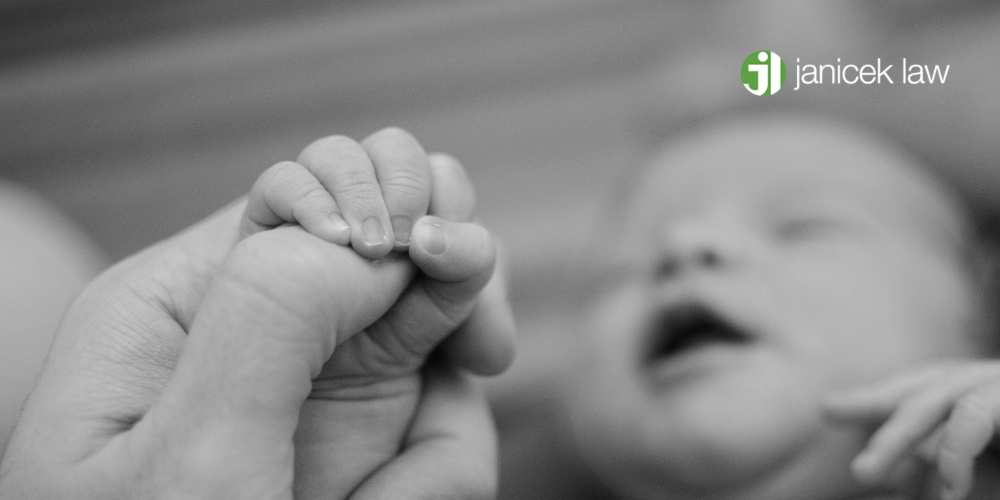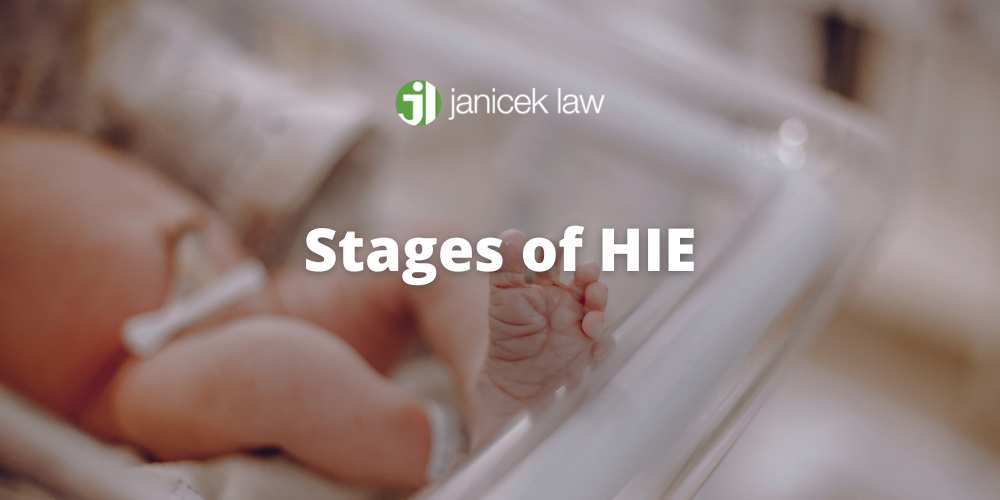Hypoxic-ischemic encephalopathy stages, or HIE stages, categorize the severity of brain injury resulting from birth asphyxia, or initial oxygen deprivation and blood flow during childbirth. These three stages, typically classified as mild, moderate, and severe HIE, serve as a framework for assessing neurodevelopmental outcomes and guiding treatment decisions.
Each of the hypoxic-ischemic encephalopathy stages corresponds to distinct clinical manifestations, ranging the baby’s symptoms from subtle, such as lethargy and poor feeding in mild HIE cases, to severe complications like seizure activity, coma, and organ or brain dysfunction in moderate to severe HIE cases.
Child health professionals, especially those in a neonatal intensive care unit setting, use HIE stages to facilitate early intervention of the condition, determine therapeutic interventions, and prognosticate outcomes for infants with HIE. Additionally, understanding hypoxic-ischemic encephalopathy stages aids in counseling families about the potential long-term implications and guiding rehabilitation efforts.
The birth of your child is supposed to be one of the most joyful days of your life, but medical malpractice causing a birth injury can ruin more than just that one day–it can cause serious, lifelong damage. If your child has suffered from a hypoxic-ischemic brain injury as a result of a medical error, you may be able to recover compensation for your losses. The San Antonio legal advocates for birth injuries at Janicek Law can help you seek justice on behalf of your infant child.
Call 210-366-4949 to schedule a free consultation with a San Antonio medical malpractice lawyer on our team regarding your birth injury case.
What is Hypoxic Ischemic Encephalopathy (HIE)?
Hypoxic ischemic encephalopathy (HIE) is a form of brain damage that is caused when a baby doesn’t get enough oxygen, often referred to as birth asphyxia. An HIE diagnosis most commonly affects newborns just before, during, and soon after birth and is the most common form of neonatal encephalopathy, or brain damage in newborns.
When a baby doesn’t get enough oxygen, this leads to damaged brain cells and, eventually, brain cell death. Without early intervention, this cell death can cause widespread neurological damage to the developing brain.
Our San Antonio HIE lawyers have years of experience in handling neonatal encephalopathy birth injury cases. If a medical provider failed to recognize the initial injury and provide a timely diagnosis of HIE, and your child’s HIE led to severe disabilities, contact a San Antonio birth injury lawyer at Janicek Law.
HIE Statistics in the United States
According to a 2000 study, hypoxic-ischemic encephalopathy occurs in about 1-4 out of every 1000 live births in developed countries. While hypoxic-ischemic brain injury isn’t extremely common in developed countries, perinatal asphyxia, one of the main causes of HIE, is also one of the leading causes of neonatal deaths worldwide. HIE mortality rates vary across different studies, but approximately 20-50% of infants with HIE die early in life, and the surviving 25-60% of survivors suffer from various neurological disabilities.
What Causes Lack of Blood Flow to a Baby’s Brain?
Lack of cerebral blood flow to a developing brain, leading to conditions like Hypoxic-Ischemic Encephalopathy (HIE), can result from various factors during the perinatal period. Factors for cerebral blood flow deprivation may include the following:
- Umbilical Cord Issues: Compression or prolapse of the umbilical cord can restrict blood flow to the baby’s brain, reducing oxygen supply.
- Placental Problems: Insufficient blood flow through the placenta due to conditions like placental abruption or placental insufficiency can lead to oxygen deprivation in the baby.
- Maternal Hypotension: A sudden drop in the mother’s blood pressure during labor can diminish blood flow to the baby’s brain.
- Uterine Rupture: This is a rare but serious complication where the uterus tears during labor, potentially disrupting blood flow to the baby.
- Fetal Distress: Signs of fetal distress during labor, such as abnormal heart rate patterns, may indicate compromised oxygen supply to the baby’s brain and can lead to perinatal asphyxia.
- Prolonged Labor: Prolonged labor or difficult delivery can increase the risk of perinatal asphyxia.
Signs of hypoxic-ischemic encephalopathy can include fetal distress, weak muscle tone, low neonatal reflexes, and movement abnormalities. It’s important that the fetus’s and baby’s symptoms are monitored to minimize complications.
Contact our San Antonio perinatal asphyxia lawyers to learn more.

What are the Stages of HIE
Hypoxic-ischemic encephalopathy stages, or HIE stages, range from mild to severe, depending on the duration and severity of initial oxygen deprivation. A clinical and electroencephalographic study published in 1976 outlined the three stages of Hypoxic-ischemic encephalopathy (HIE), which we still refer to today. Below are those three stages of HIE that infants can suffer from, according to the clinical and electroencephalographic study:
Mild HIE
Mild hypoxic-ischemic encephalopathy, commonly known as mild HIE or stage 1 HIE, can cause mild behavioral issues like:
- Irritability or excessive crying
- Sleepiness
- Hyper-alertness
- Slightly decreased muscle tone
- Fast heart rate, or tachycardia
- Poor feeding
- Stronger deep tendon reflexes
For mild HIE, the baby’s symptoms can be hard to distinguish from normal infant behaviors and will usually resolve themselves within 24-72 hours. Less than 5% of infants who suffer from mild HIE develop severe disabilities.
Moderate HIE
Infants with moderate hypoxic-ischemic encephalopathy, or stage 2 HIE, may suffer from more noticeable issues:
- Lethargy or extreme tiredness
- Apnea or other breathing problems
- Deficient muscle tone
- Small pupils
- Diarrhea
- Lack of deep tendon reflexes
- Lack of response to physical stimuli
- Extended legs and flexed arms
- Slow heartbeat
- Seizures within 24 hours after birth
This stage of hypoxic-ischemic encephalopathy can last anywhere between 2-14 days, but the brain damage caused by the lack of oxygen can result in serious, life-long consequences. About 25-75% of infants with moderate HIE suffer from a severe handicap or die early in life.
Severe HIE
Severe Hypoxic-Ischemic Encephalopathy, or severe HIE, designated as Stage 3 of the HIE stages, signifies a critical medical condition arising from birth asphyxia or oxygen deprivation to the brain, frequently occurring during childbirth.
Symptoms of severe HIE can include:
- Stupor
- Coma
- Lack of deep tendon reflexes
- Deficient muscle tone throughout the whole body
- Erratic breathing that often necessitates ventilation
- Absent neonatal reflexes
- Irregular eye movements and unresponsive or dilated pupils
- Seizures 24-48 hours after the baby’s initial injury
- symptoms suggestive of cerebral edema
- Irregular heartbeat
- High blood pressure
About 75% of infants who receive this diagnosis of HIE develop a severe handicap or die early in life. Severe HIE can induce profound and enduring neurological impairments in affected infants. Stage 3 HIE is typified by a substantial deterioration in brain function, potentially leading to seizures, coma, lack of deep tendon reflexes, lack of muscle tone, irregular heartbeat, or fatality.
Infants diagnosed with severe HIE often face an uncertain prognosis, with many enduring lifelong complications such as developmental delays, cognitive impairment, motor deficits, cerebral palsy, and quadriplegia. Early intervention with intensive treatment is imperative to mitigate the extent of brain damage and enhance long-term prospects for these infants.
Progression of Hypoxic-Ischemic Encephalopathy Stages

Primary Energy Failure
Blood flow delivers crucial nutrients like oxygen and glucose to the body, especially the brain, for energy. In hypoxic-ischemic encephalopathy (HIE), primary energy failure deprives the brain of these nutrients, leading to adenosine triphosphate (ATP) deficiency. This primary energy failure triggers lactic acid production, causing brain swelling and disrupting the sodium-potassium pump, allowing excess calcium into brain cells. This cascade leads to brain cell death, DNA fragmentation, and restricted blood flow. Moderate to severe HIE also results in multiorgan dysfunction due to oxidative damage, often exacerbated by low blood pressure in approximately 62% of cases.
Cell Death
During primary energy failure, two forms of cell death occur: necrosis and apoptosis. Necrosis cell death involves cell swelling and rupture, leading to the destruction of the cellular membrane and release of contents, causing inflammation. This type is most common in severe HIE.
On the other hand, apoptosis involves cell shrinkage and death without membrane damage or inflammation. While apoptosis is less damaging, both forms can impair normal brain development, leading to permanent brain injury.
Latent Period
The latent period of hypoxic-ischemic encephalopathy (HIE) represents a recovery period observed in patients with moderate to severe HIE. It involves the restoration of blood flow to the brain and typically lasts from one to six hours. This phase presents an optimal window for therapeutic intervention if deemed appropriate for the infant by the neonatal intensive care unit.
While blood, oxygen, and nutrients are reintroduced into brain tissues during this phase, the damage from primary energy failure persists, and processes like neuroinflammation and cell death reactions persist. Ultimately, the latent period transitions into secondary energy failure.
Secondary Energy Failure
Secondary energy failure typically occurs within six to 48 hours after the acute phase in moderate to severe HIE cases, often resulting in more severe damage compared to primary energy failure. However, the severity of the initial injury influences the extent of this phase’s impact.
During secondary energy failure, the brain experiences reperfusion or hyperperfusion, characterized by excessive blood flow. This phase’s mechanisms, including angiogenesis, cerebral vasodilation (an effect on cerebral blood flow), oxidative stress, excitotoxicity, and inflammation, contribute to further injury.
Managing oxidative stress is challenging due to increased oxygen consumption after birth. Excitotoxicity may lead to long-term impairments in hearing, vision, somatosensory function, learning, memory, and child development.
The damage from this phase exacerbates cell death and sets the stage for injury to other organs.
Tertiary Phase of Moderate to Severe HIE
The tertiary phase occurs in the weeks and months following secondary energy failure, during which the baby’s alertness may gradually improve approximately four to five days after the initial injury, and brain repair and remodeling processes are initiated.
However, brain damage may persist for months to years. Normal brain development in early childhood involves rapid neuronal and synaptic growth as the child learns and adapts, facilitated by neural plasticity. Moderate to severe HIE can hinder neuronal development and reduce plasticity, leading to ongoing brain damage and developmental impairment. Children affected by moderate to severe HIE may experience persistent reduced muscle tone and feeding difficulties, often requiring tube feeding for weeks or months.
Neonatal Brain Injury Treatments

A diagnosis of HIE can be scary, but there are ways to effectively treat HIE and prevent severe brain damage. One of the most well-established and effective treatments for a neonatal brain injury like hypoxic-ischemic encephalopathy is therapeutic hypothermia, commonly known as cooling therapy or whole-body hypothermia.
Therapeutic hypothermia during the newborn period involves carefully lowering the infant’s body temperature for a specified duration to reduce inflammation, metabolic stress, and further symptoms of neonatal encephalopathy. In clinical trials, therapeutic hypothermia has been shown to improve neurological outcomes and decrease the severity of disabilities when used in the first few hours after birth.
In addition to whole-body hypothermia, other supportive treatment options can help maintain vital functions. These treatments can include anti-seizure medications, a breathing tube to improve breathing, blood pressure medications, and more.
While medical providers agree these treatments are necessary, they can lead to decreased kidney and liver function, blood clots, and infant distress if not adequately monitored.
What Are the Long-Term Effects of HIE?
Neonatal hypoxic-ischemic encephalopathy can have enduring consequences that significantly impact a child’s life as they grow. These long-term effects can manifest in various ways, affecting different aspects of their physical, cognitive, and emotional development.
Poor Motor Skills
Depending on the severity and location of brain damage, children who have experienced HIE may exhibit difficulties in coordination, muscle strength, and balance. This can manifest as challenges in activities such as walking, crawling, and fine motor tasks like writing or buttoning clothing. Physical therapy and rehabilitation are often necessary to address these motor skill deficits, helping children regain as much functional independence as possible.
Cognitive Development
HIE can also cause cognitive impairment, leading to learning disabilities and delays in intellectual growth. Children affected by HIE may struggle with tasks requiring memory, attention, problem-solving, and academic achievement. Additionally, infants who suffer from HIE may develop cerebral palsy, a form of abnormal brain development that can cause lifelong disabilities. If your baby develops cerebral palsy due to medical negligence, you have grounds to contact a San Antonio cerebral palsy lawyer at Janicek Law.
Behavioral Issues
Due to the cognitive impairments tied to hypoxic-ischemic encephalopathy, children who suffer from HIE often exhibit certain behavioral and emotional issues, including anger, aggression, frustration, and attention-related difficulties. They may also experience anxiety, depression, or hyperactivity and may have trouble interacting with others in social settings. Behavioral therapies, counseling, and a supportive environment can help manage and address these issues to improve the child’s overall quality of life and social functioning.
Vision and Hearing Problems
HIE is also linked to an increased risk of vision and hearing problems. Brain damage resulting from oxygen deprivation can affect the optic nerves and auditory pathways, resulting in visual impairments or hearing deficits. Children with an HIE diagnosis may require regular vision and hearing assessments, along with interventions such as glasses or hearing aids, to address these issues.
Epilepsy
Epilepsy is another common long-term consequence of HIE, but it’s particularly prevalent in cases of moderate to severe HIE. After an episode of oxygen deprivation, the brain is more vulnerable to seizure activity. Children with HIE-related epilepsy may experience recurrent seizures that can be challenging to manage and may impact their quality of life.

Can You Sue for HIE?
Yes, in certain situations, you can sue medical professionals for your child’s HIE. Hypoxic-ischemic encephalopathy can be caused by medical errors, such as birth trauma and umbilical cord complications. Not only that, but the infant’s condition can progress and worsen without timely medical intervention. This can easily lead to permanent brain injury or even wrongful death.
When newborn infants suffer from HIE as a result of a medical error, whether by medical professionals in labor and delivery or the neonatal intensive care unit, the newborn’s parents can file a medical malpractice suit against the professional or professionals responsible for their child’s injuries.
It’s important to note that not all cases of HIE are the result of medical malpractice, so it’s important to review your potential claim with a San Antonio medical malpractice lawyer who can help determine eligibility. They can evaluate your situation for any acts of negligence and build a case on your behalf so that you can recover compensation for your losses.
Proving Negligence in a Birth Injury Case
In order to file a successful medical malpractice claim, an attorney must be able to prove that one or more medical providers committed an act of negligence. This can be done by establishing the four elements of negligence, which include:
- A duty of care – a responsibility to provide the patient with a minimum standard of care
- A breach of duty – a failure to provide the patient with the minimum care
- Causation – a link between the patient’s losses and the breach of care
- Damages – any losses the patient suffered as a result of the breach of care
In the case of hypoxic-ischemic encephalopathy, a medical professional must fall short of the expected standard of care, usually by:
- Failing to properly monitor the fetus before birth
- Failure to properly monitor the mother before birth
- Failure to treat maternal infections before birth
- Making a mistake in the delivery process
- Failing to provide timely surgical interventions like a C-section
- Failing to provide timely therapeutic interventions like cooling therapy
- Failure to properly evaluate and treat the infant in the first month of life
In order to prove this, attorneys will call upon another medical professional in the same position with similar skills who can testify as to what they would do in the given situation. This can establish a baseline of care, and if the medical professional accused of malpractice does not meet this standard of care, they may be found negligent.
Attorneys will also gather evidence that illustrates the extent of the victim’s losses, which can help ensure that they receive compensation for all past losses, as well as their future losses. For example, if the victim’s infant developed cerebral palsy as a result of moderate HIE, the victim can claim damages like medical expenses, physical therapy expenses, and the cost of any assistive equipment their child needs as a result of their condition.
Proving negligence in a birth injury case is a complex legal process that requires thorough investigation, expert testimony, and a compelling presentation of evidence. That’s why it’s so important to find a dedicated legal team who can investigate your situation and build a case on behalf of you and your child.
Birth Injury Damages
Parents of children with hypoxic-ischemic encephalopathy can suffer from a number of economic and non-economic damages as a result of their child’s personal injuries. The amount of compensation a victim can recover in a medical malpractice suit will often reflect the circumstances surrounding the birth injury and the long-term consequences for infants with HIE
Parents of children with hypoxic-ischemic encephalopathy can recover compensation for economic damages such as:
- Medical expenses;
- Physical therapy expenses;
- Counseling expenses;
- Lost wages;
- Assistive equipment;
- Home modifications for child’s condition;
- In-home care expenses;
- Funeral and burial expenses in the event of a wrongful death. For more information about these types of damages, contact a San Antonio wrongful death lawyer today.
Parents of children with hypoxic-ischemic encephalopathy can recover non-economic damages such as:
- Emotional distress
- Loss of enjoyment in life
- Permanent disability
- Disfigurement
- Pain and suffering
San Antonio Birth Injury Attorneys for Hypoxic-Ischemic Brain Injury Claims

If your child has suffered a birth injury, the experienced legal team at Janicek Law is here to help you navigate the complex and often emotionally challenging journey ahead. Our dedicated San Antonio birth injury attorneys have a deep understanding of various birth injury cases, including those involving hypoxic-ischemic encephalopathy, cerebral palsy, and other HIE-related injuries.
We will review the details of your case, answer your questions, and provide you with a clear understanding of your legal options. Together, we can work towards holding responsible parties accountable for the harm caused to you and your child.
Call us at 210-366-4949 or contact us online to schedule a free consultation with a member of our expert legal team.

